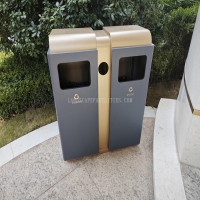Welcome to the website for landscape facilities products and knowledge.
How do manufacturers address the challenge of producing non-reflective surfaces for trash cans?
Producing non-reflective trash cans is a critical challenge for manufacturers, especially in urban environments where glare from polished surfaces can disrupt aesthetics and visibility. To address this, manufacturers employ several innovative techniques.
One common method is applying matte finishes or textured coatings to the surface of trash cans. These coatings diffuse light rather than reflecting it, reducing glare significantly. Materials like powder-coated steel or matte-finished plastics are popular choices due to their durability and low reflectivity.
Another approach involves using specialized paints with light-absorbing pigments. These paints not only minimize reflection but also resist weathering, ensuring long-term performance. Some manufacturers even incorporate nano-coatings that scatter light at a microscopic level, further enhancing the anti-glare effect.
For high-end solutions, manufacturers opt for composite materials with built-in non-reflective properties. These materials, often used in architectural settings, combine functionality with sleek design. Additionally, surface patterning—such as embossing or etching—can break up light reflection while adding visual appeal.
Beyond aesthetics, non-reflective trash cans offer practical benefits. They reduce eye strain in public spaces and blend seamlessly into urban landscapes. As sustainability grows in importance, manufacturers are also exploring eco-friendly matte coatings made from recycled materials.
By leveraging advanced materials and coatings, manufacturers successfully meet the demand for non-reflective trash cans, balancing functionality, durability, and urban design.
Related search:

Recommendation
Double-bucket garbage bin, outdoor, metal, multi-color, powder-coated, double-bucket trash can